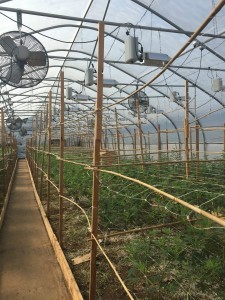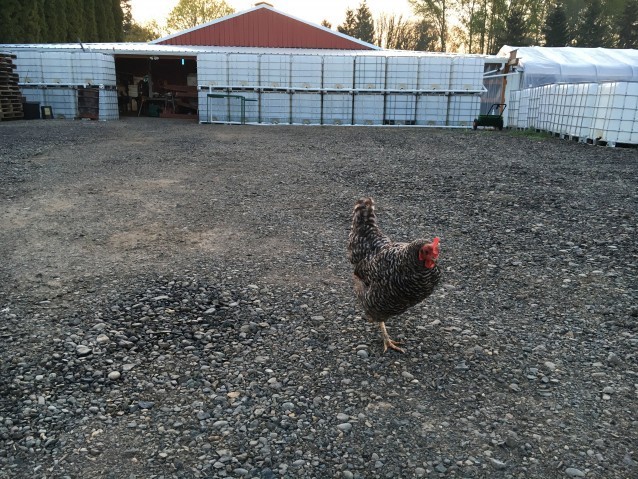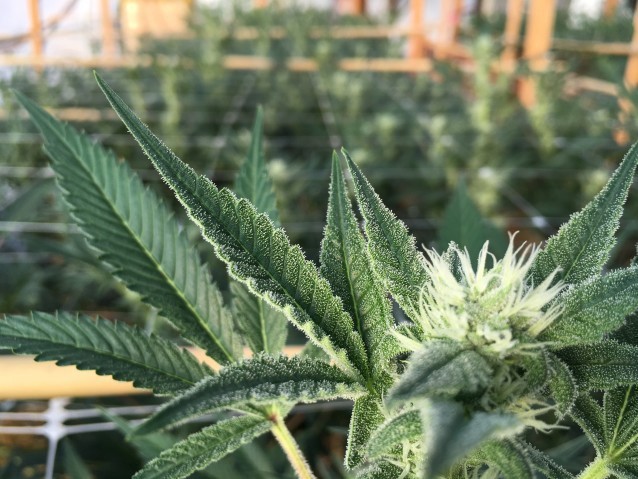Sustainable marijuana planting

Tyson Haworth runs a quarter-acre cannabis farm in rural Oregon. He grew up in his father’s wholesale produce company and was the manager of a wholesale organic distribution company. In 2007, his wife underwent a second back operation. She took opiates the first time around and didn’t want them again. Haworth started growing medical marijuana for both her and the medical market. He did this on the side but in 2013, after the Oregon medical marijuana market shifted, allowing for a legitimate retail component, he suspended his organic produce job and went into fulltime marijuana cultivation. In 2014 he moved SoFresh farms to Canby.
Not wanting to drop the amount of knowledge he had gained on organic produce, he decided to create an organic, sustainable cannabis farm without any synthetic pesticides or fertilizers. To grow marijuana and leave the environment better, he prefers predatory bacteria, fungi and bugs instead.
Tyson cares a lot about reducing waste on the farm. He turn plant trimmings into nutrient-dense plant food with the help of lactic acid bacteria. The rest of trimmings turns into compost and into chicken food. Haworth grows five rounds of smaller plants in a year instead of growing three rounds of large plants which lowers energy needed to grow the plants.
Rainwater from the roof of the barn and condensate from the dehumidifiers and air-conditioning units goes into a water reclamation system and then uses for irrigation.

Haworth think about the efficiency of his operation all the time. He identifies waste source, and figures how it can be turned into a revenue source or lower expenses. His intention is to make a closed-loop system where everything feeds off the waste from the previous cycle.
Haworth’s cannabis was one of the first brands to claim a Clean Green certification. It helps Haworth keep prices for his products high so all the sustainability effort makes financial sense.

Haworth still uses high-pressure sodium bulbs on his farm because he can’t get the same quality and yield from LEDs. But he hasn’t tried any of the new lights that have come in the past few months on the market.
Haworth thinks that as the price of marijuana begins to be forced down by the legal market, greenhouses will come as the future of cannabis cultivation. Indoor growing will not be financially reasonable for growers. In no other industry, plants are grown indoors. Mostly people use greenhouses. Using natural sunshine has helped Haworth to significantly cut on the amount of energy that he uses.

Environmental impacts of cannabis cultivation
Indoor planting requires a lot of electricity
Since a third of marijuana cultivation currently takes place in indoor warehouses, cannabis is the most energy-intensive crop in the country. The process requires huge amounts of lighting, cooling, ventilation and dehumidifying.
A report released by New Frontier Financials in 2016 showed that, cannabis cultivation in United States consumes one percent of the total electricity annually, which for a single industry cultivating one crop is a lot. Roughly, equivalent to the electricity used in 1.7 million homes. If the consumption of energy by indoor marijuana operations continues at this rate, in the next 20 years the electricity used in the Northwest will increase twofold.
Growing marijuana indoors requires artificial lighting for between 12 and 18 hours a day. High Intensity Discharge (HID) lamps have conventionally been preferred to by most indoor cultivators because of how they emit an intense light for a fairly cheap price. But they can get really hot and some can increase the temperature of the grow room by up to 30 degrees Fahrenheit. So as to reduce the risk of overheating their crops or destroying the flavor and aroma of the cannabis flower, cultivators who use HIDs need to find a way to lower the temperature in their growth sites. Most growers heavily rely on dehumidifiers and air conditioning units to maintain a steady temperature for their warehouse.
All that equipment left on for half a day or more adds up to an expensive electricity bill. For example, a 25,000 square foot indoor grow site powered by high-pressure sodium lights (HPS) in Portland, Oregon would consume electricity for about $30,000 each month.
The first reason for indoors growing is that according to federal law, cannabis is still a Schedule I controlled substance. Cultivating indoors secures growers from attracting the attention of law enforcement. It can be an issue even in states where the drug is legal, like Oregon. The Drug Enforcement Administration searches for marijuana farms by helicopter and then sends officers trample though the woods to pull out plants under cannabis eradication program.
But growing cannabis indoors has other benefits like allowing the grower to precisely control the conditions, from the amount of light to how much heat the plants receive. This makes the process more replicable with fewer uncontrolled variables, which is important in any business.
A study done in 2013 in Washington concluded that, the most important environmental impact of marijuana production for recreational use in the legal market is likely to be the energy for indoor growing. Since most of the energy used for illegal growth comes from off-grid sources, gasoline or diesel fuel generators, it comes with a very heavy carbon footprint. Estimated carbon dioxide emission to the atmosphere for every kilogram of marijuana, grown indoors is 4600 kilograms. The same as burning almost 5000 pounds of coal.
Outdoor planting requires a lot of water and degrades land
Starting outdoor cultivation for marijuana is hard since it is a very unpredictable plant. It requires a particular climate. If done improperly, outdoor cultivation can erode soil, degrade land or lead to pesticide and fertilizers runoff. Also growing cannabis outdoors requires a lot of water. Twice the amount needed to grow wine grapes.
Ecologists at the University of California published a paper in 2015, looking at the effect of outdoor cannabis cultivation on a sensitive ecosystem. They found that illegal marijuana cultivation have a huge impact on water resources and flow in the previously degraded Eel River watershed in Mendocino County that had recently begun to recover from the damaging effects of half a century of logging and soil erosion. They also found that pesticides used by cannabis growers against pests, often harm wildlife. The presence of rodenticides frequently used by cannabis cultivators was found in 80 percent of dead Pacific fisher. This rare weasel-like animal is a potential candidate for listings in the Federal Endangered Species Acts.
New technologies to lessen environment damage
The study concluded that virtually all types of agriculture have the same tension as those between marijuana cultivation and the ecosystem. Just like in other industries, it should be quantified and debated openly. To prevent and lessen the environmental damage associated with cannabis cultivation, there is a major need to broaden the conversation that contain the environmental concerns and how to explore current and future marijuana policies.
Cannabis cultivators in a way are a traditional bunch. They stick to what they know works rather than try out untested technologies. Not that different from staple food farmers who also hesitate to try new methods that could reduce greenhouse gas emissions but also bring about a decrease in yields. However, this could begin to change with the advent legal market of the drug and cannabis growers might look to other agricultural sectors to find out how to cut down their operational overhead.
The CEO of Terra Tech, a California high-tech greenhouse company, Derek Peterson says that in the cannabis industry, the biggest issue with sustainability is that they have not been forced to do anything differently. He has been trying for years to convince growers to try out a new piece of technology - switch to the high-tech greenhouses. They don’t want to change something that works and don’t know how to operate that technology.
Greenhouses
Looking forward to cannabis in a national market and how the industry is experiencing rapid expansion, entrepreneurs like Peterson are tabling at the chance to bring technology to cultivators. Peterson founded Terra Tech in 2009 at the beginning of the medical cannabis market. First, he researched lighting and hydroponic technologies to help boost cannabis growing and yields respectively. Then, he turned into sustainability.
He bought a plot of land in New Jersey and built a 5-acre Dutch-style glass greenhouse with hydroponics inside. Peterson believes that cannabis cultivation future is greenhouses.
Using sunshine as an easy way to reduce the energy cost and incorporating technology in greenhouses could be where cannabis cultivation is headed. Some greenhouses even have sensors that automatically turn lights on when a cloud blocks the sun, so electric light is used only when there is not enough sunshine for growing the plants.
Monitoring software
However, greenhouses are not the only solution that the marijuana industry is looking as a means to reduce the environmental footprint. Another suitable option, as the CEO and founder of Green Lion, Mike Bologna believes, is better technology. Working on software that can monitor and track the cannabis cultivation from seed to sale, Bologna hopes to help growers comprehend the way their crops react to all changes from water to light and temperature. It makes cannabis growers more informed about the inputs and helps with decisions about techniques they can use to cultivate their crop.
LED lights
LED lights is also said to reduce the operations energy use for indoor cultivation by a significant number. Growers are beginning to experiment on this next-generation growing technology which is the future of indoor cannabis cultivation. These lights last for ten to twenty years and are twice efficient than high-pressure sodium lamps. They give off less heat therefore reducing the need for growers to use air conditioning by around two thirds what they normally would.
Though most traditional growers say that LEDs have a reputation of failing to deliver to their big promises, others like Pink House in Colorado have already started experimenting on the next-generation lights that recently came on the market like LEDs produced by Swedish company Heliospectra.
Switching to LEDs is a huge spending. They four to five times more expensive than high-pressure sodium bulbs. But with the savings in electricity bills and replacement bulbs, they provide a substantial return on investment in the long-run and as the market prices drop, growers will need to look for ways to cut down on their production scheme. LED is an obvious place for growers to look for ways to grow cheaper.
What makes it more difficult for the cannabis industry to completely embrace sustainable techniques is the drug’s regulatory status and how they deal with this status on a case-to-case approach. Each states has unique regulations and within a state, separate regulatory bodies deal with issues of energy efficiency, water, pollution and pesticide use turning the requirements into an intricate web of bureaucratic red tape.
Clean Green label certification
Cannabis can’t be labeled organic by USDA since it’s still federally illegal. Not having an organic label to help the product get a quality price in the market, makes it difficult to convince growers to implement sustainable technologies. The cannabis industry has established its own certification, the Clean Green label. It works analogously to the USDA organic certification for cannabis growers who use organic practices.
But the Clean Green certification is much less recognizable then the USDA’s organic label. Unlikely a novice cannabis buyer on their first trip to a dispensary would know about Clean Green certification.
Legal issues
When talking about legalization of marijuana, people in this industry talk about it with a level of assurance. They say it will happen and it will happen soon. This will in turn bring an entire new set of issues. A big issue that is rapidly increasing in the marijuana industry as legalization becomes widespread is the environmental footprint. But factoring the environmental concerns into statewide regulations has been slow.
In Oregon, applications for recreational cannabis growers are handled by the Oregon Liquor Control Commission (OLCC). It has only just begun to concern growers’ environmental impacts. The first meeting of the Task Force on Cannabis Environmental Best Practices, which is a part of the OLCC, was on April 12, 2016. Oregon Department of Agriculture deals with pesticide use and water-quality concerns. However, they lack strict enforcement mechanisms, so water or pesticide measures are mostly voluntary actions taken by growers.
Laws can be potential drivers for unsustainable business practices. In some cases, the regulations can make production of cannabis less sustainable. Washington passed a bill (before it was revised) limiting production of recreational marijuana to indoor facilities only. In Oregon, it’s required a 100-foot distance between the plants and the edge of the property to grow cannabis outside. And in Nevada, the crop can’t be grown in a building with transparent sides. It rules out greenhouses of Dutch-style glass that companies like Terra Tech use. The only option to grow cannabis under the state’s current medical regulations is indoors.
In other places, like Colorado’s Boulder County, environmental rules added into cannabis regulations. Since 2015, Boulder County obligated licensed cannabis grower to obtain all their electricity from renewable energy sources. Those growers who unable to switch completely to renewable energy, can instead pay a 2.16 cent charge per kWh into the Boulder County Energy Impact Offset Fund. Money is then used to educate cannabis growers how to reduce energy consumption and gain advantage from renewable energy sources.
Mostly, the industry supports this program. However, the federal illegal status of cannabis might be the leading obstacles to marijuana sustainability. Cultivators find it hard to seize advantage of some incentives in the fear of not wanting to cross federal regulations. Unless cross-border trade is allowed growers will be forced to continue indoor and greenhouse cultivation in places where cannabis doesn’t grow well outside.



